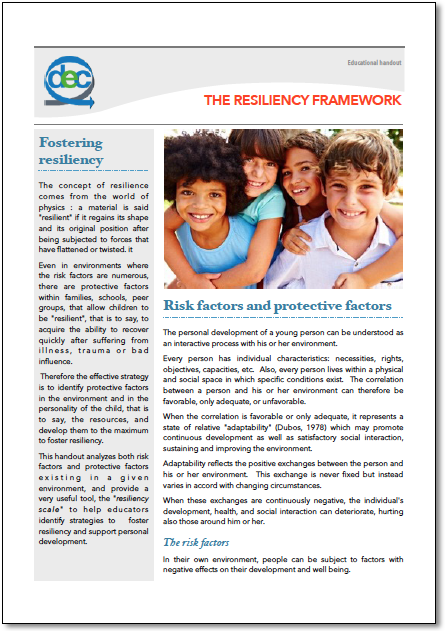Educational handouts
The Resiliency Framework
The personal development of a young person can be understood as an interactive process with his or her environment.
Every person has individual characteristics: necessities, rights, objectives, capacities, etc. Also, every person lives within a physical and social space in which specific conditions exist. The correlation between a person and his or her environment can therefore be favorable, only adequate, or unfavorable.
When the correlation is favorable or only adequate, it represents a state of relative "adaptability" (Dubos, 1978) which may promote continuous development as well as satisfactory social interaction, sustaining and improving the environment.
Adaptability reflects the positive exchanges between the person and his or her environment. This exchange is never fixed but instead varies in accord with changing circumstances. When these exchanges are continuously negative, the individual's development, health, and social interaction can deteriorate, hurting also those around him or her.
The concept of resilience comes from the world of physics : a material is said "resilient" if it regains its shape and its original position after being subjected to forces that have flattened or twisted it.
Even in environments where the risk factors are numerous, there are protective factors within families, schools, peer groups, that allow children to be "resilient", that is to say, to acquire the ability to recover quickly after suffering from i l l n e s s , t r a uma o r b a d influence.
Therefore the effective strategy is to identify protective factors in the environment and in the personality of the child, that is to say, the resources, and develop them to the maximum to foster resiliency.
This handout analyzes both risk factors and protective factors e x i s t i n g i n a g i v e n environment, and provide a very useful tool, the "resiliency scale " to help educators identify strategies to foster resiliency and support personal development.
With the “resiliency“ scale you will have a very practical and convenient tool to record observations made on children, and analyze their strengths and weaknesses in four main areas : Social competences, Problem solving / Decision making / Critical thinking, Autonomy and Meaning of Life. From that you will be able to identify the development needs of each child and set up relevant educational objectives.
You can get this handout for only 2,50 euros. You have just to click on the button below to order and pay it. You will receive very soon a link to download it directly on your computer. Just try and write your comment.
(bouton désactivé car la formule Platinum du blog a expiré)

